|

English
Japanese 中文 한국어

12 minutes movie to get brief understanding of what
really happened.
Photos of Nanking
Under the Japanese Occupation
(Click for
larger image)

After the battle, many Nanking citizens, who had abhorred bad deeds done by
the Chinese military in the city, welcomed the Japanese military. This is a
photo of Japanese soldiers and the Nanking citizens giving cheers, on the day
of the Japanese military’s ceremonial entry into Nanking (Dec. 17, 1937, 4
days after the fall of Nanking). The citizens are wearing armbands of the
flag of Japan, which were given to all civilians of Nanking to distinguish
them from hiding Chinese soldiers in civilian clothing. (“Sino-Japanese War Photograph
News #15,” the Mainichi Shimbun
newspaper, published on Jan. 11, 1938)
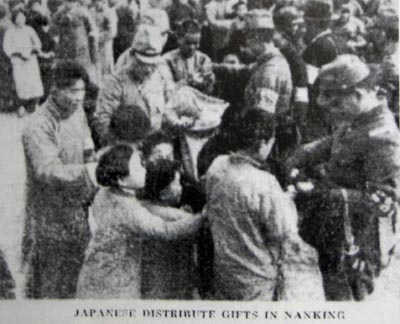
Japanese
soldiers distributing gifts to Chinese citizens in Nanking.
Photo from the British newspaper North China Daily News, published in China
in English on December 24, 1937, eleven days after the
Japanese occupation of Nanking
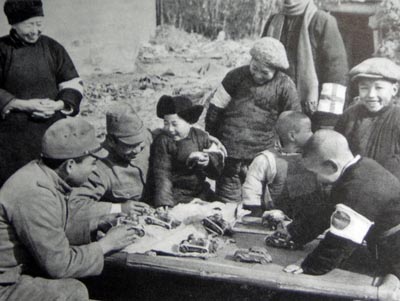
Japanese
soldiers playing with Chinese children in Nanking using toys, and their
parents wearing armbands of the flag of Japan. Photo taken on Dec. 20, 1937,
seven days after the occupation, and published in the pictorial book, Shina-jihen Shasin Zensyu, in 1938.
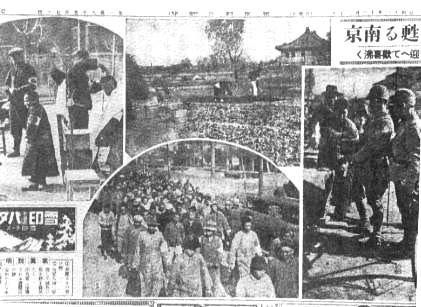
The Japanese newspaper Asahi Shimbun, published on Dec. 18, 1937, five days after the
occupation, reported scenes of the city in the article
entitled, “Nanking
in Restoring Peace”:
(Right) Japanese soldiers buying from a Chinese;
(center top) Chinese farmers who returned
to Nanking cultivating their fields;
(center bottom) Chinese citizens returning to Nanking;
(left) Street barbershop, Chinese adults and children smiling.

The Asahi Shimbun, published on
Dec. 21, 1937, eight days after the Japanese occupation, reported
scenes of Nanking in the article entitled, “Kindnesses to Yesterday’s Enemy”:
(Right top) Chinese soldiers under medical treatment;
(left top) Chinese soldiers receiving food from a Japanese;
(center) Japanese soldiers buying at a Chinese shop;
(right bottom) Chief Yamada talking with a Chinese leader;
(left bottom) Chinese citizens relaxing in Nanking city
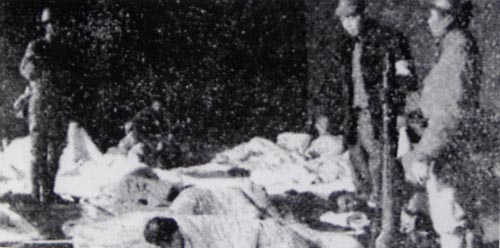
Chinese
people sick or wounded in a hospital in Nanking
and Japanese medics nursing them. Photo from the North China
Daily News on December 18, 1937, five days after the occupation of Nanking.
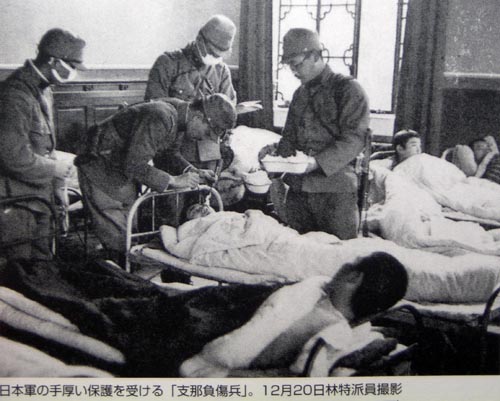
Japanese
soldiers nursing Chinese wounded soldiers. Photo taken in Nanking
on December 20, 1937, seven days after the occupation, by
the correspondent Mr. Hayashi; placed in the Japanese pictorial magazine, Asahi-ban Shina-jihen
Gaho, and published on January 27, 1938.
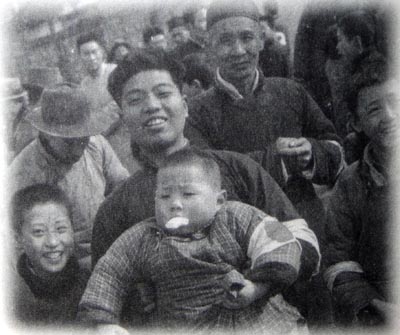
“The Chinese citizens did not fear the Japanese and willingly cooperated with
me for photo-taking,” testified the press photographer Shinju Sato. Photo
taken in Nanking Safety Zone on December 15, 1937, two days after the
occupation of Nanking.
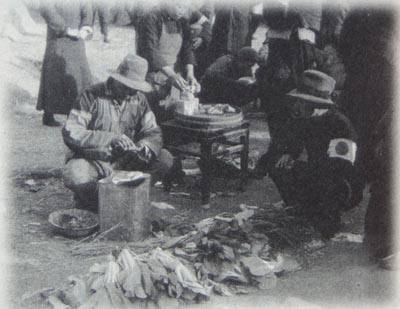
Nanking citizens with armbands of the flag of Japan selling vegetables on the
street on December 15, 1937.
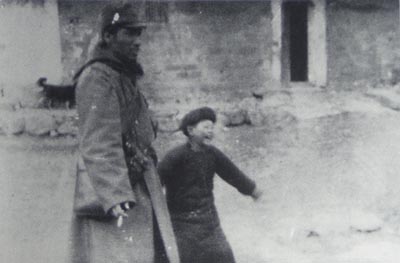
Chinese boy smiling and Second Lieutenant Takashi Akaboshi, who led a fight
along the Yangzi River. Photo taken near the walls of Nanking
just after the Japanese occupation (courtesy of
Takashi’s wife).
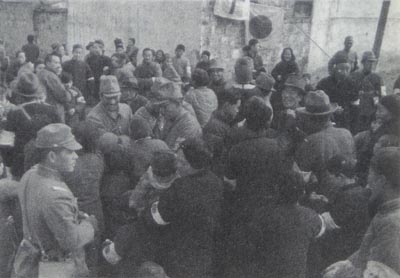
When Japanese soldiers distributed food and sweets, Chinese adults and
children gathered together. (December 18, 1937, in Nanking.
From the Tokyo Nichinichi
Shimbun.)
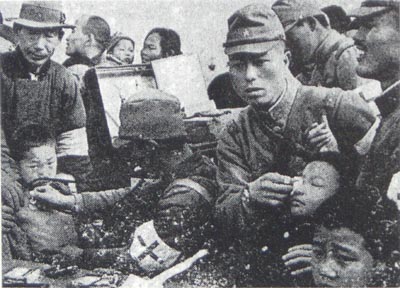
Japanese
medics giving treatments to Chinese children in Nanking
for plague prevention. Photo taken on December 20, 1937, seven days after the
occupation, by the
correspondent Hayashi. (From Asahi
Graph, book 30, No. 3, published on January 19, 1938.)
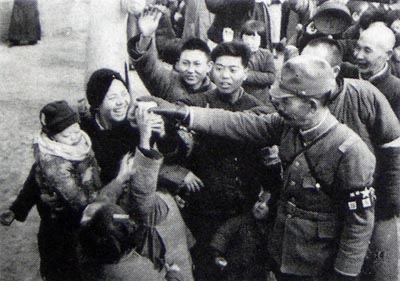
Chinese citizens rejoicing to receive confectionery from Japanese soldiers on
December 20, 1937, in Nanking. (From Asahi-ban Shina-jihen
Gaho, published on January 27, 1938.)
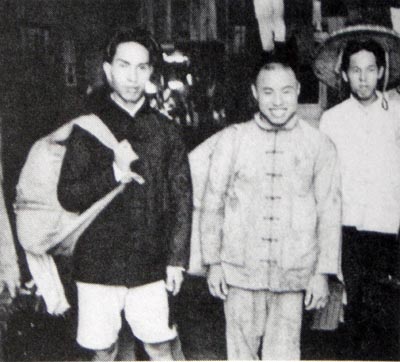
Chinese
prisoners of war going home smiling. From Japanese pictorial book, Asahi-ban Shina-jihen Gaho, “Scenes We
Want to Show to Chiang Kai-shek,” published on August 5, 1939.
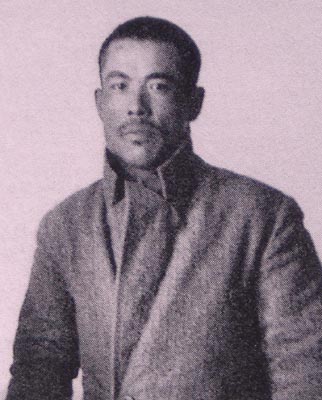
Liu Qixiong, a Chinese soldier who was hiding in
the Nanking Safety Zone and caught as a POW. He was used as a coolie for a
while, but later became the commander of a brigade for Wang Jingwei’s
pro-Japanese government. (Asahi-ban
Shina-jihen Gaho, No. 14, January 1, 1938)

Japanese
soldier handing paper money to a Chinese family in the
Nanking Safety Zone. Photo taken on December 27, 1937, fourteen days after the
Japanese occupation, by the correspondent Mr. Kageyama; from Asahi-ban Shina-jihen
Gaho, published on January 27, 1938.

Chinese
merchants selling to Japanese soldiers in Nanking.
Photo from the pictorial magazine Mainichi-ban
Shina-jihen Gaho, published on February 1,
1938.
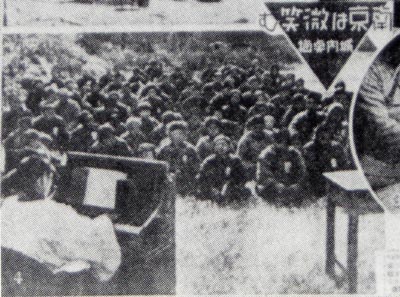
Chinese Christians having worship service in Nanking
with Reverend John Maggie, American pastor, after peace returned to the city.
Photo from the Asahi Shimbun
newspaper published on December 21, 1937, eight days after the Japanese
occupation, in the article entitled “Nanking Smiles.” The article stated,
“Hearing their hymns, we noticed, ‘Oh, today’s Sunday.’”

Chinese
women coming out of
an air-raid
shelter and protected by the Japanese military. Photo taken on December 14, 1937,
the day after the fall of Nanking, by the correspondent Kadono,
and published in the Asahi Shimbun
on December 16, 1937.
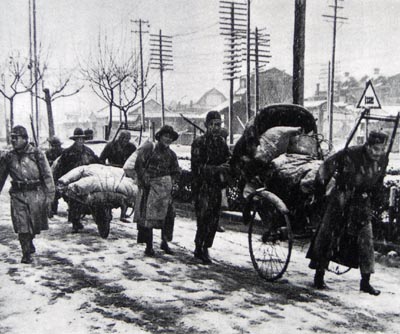
Chinese people hired by Japanese soldiers to carry food. Photo taken on
January 20, 1938, in Nanking. The Japanese
distributed the food to the citizens, and there was no death by starvation in
Nanking. (From Shina-jihen Shashin Zenshu
(2).)
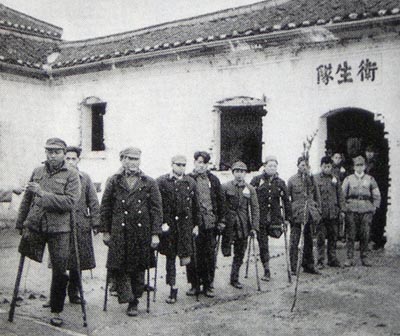
Chinese prisoners of war with legs or arms cut off recuperating in Nanking
Concentration Camp in early spring of 1938.
(From Mainichi Graph - Nihon no Senreki.)
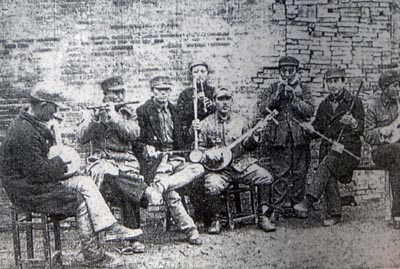
Chinese prisoners of war playing music with handmade instruments in Nanking
Concentration Camp (Mainichi-ban Shina-jihen
Gaho, No. 59, May 20, 1939.)
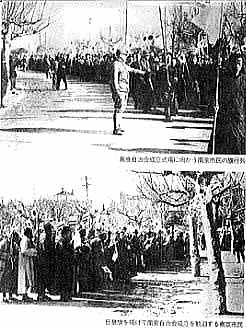
Citizens celebrating the start of Nanking’s self-government on January 3,
1938, waving the Japanese flag and the Chinese five-color flag.
Forged Photos of the “Massacre”
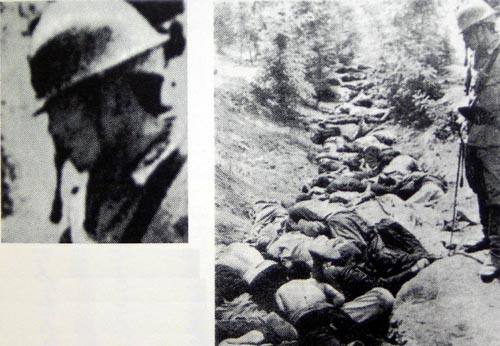
Iris Chang’s book, The Rape of Nanking,
dated this photo as having been taken just after the Nanking Massacre.
However, the alleged Japanese soldier standing by wears a military uniform
with a turned-down collar with class badges on it. This style was not
introduced until after the uniform revision on June 1, 1938. In addition, the
photo does not tell how the pictured dead were killed, by massacre or in
battle, and there were many Chinese soldiers in ordinary clothes.
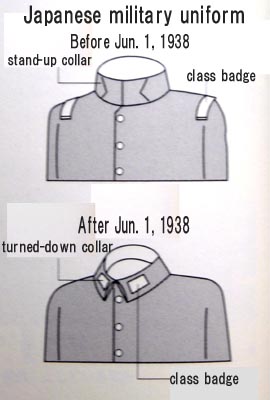
Design of Japanese Army uniforms before and after the June 1, 1938 revision.
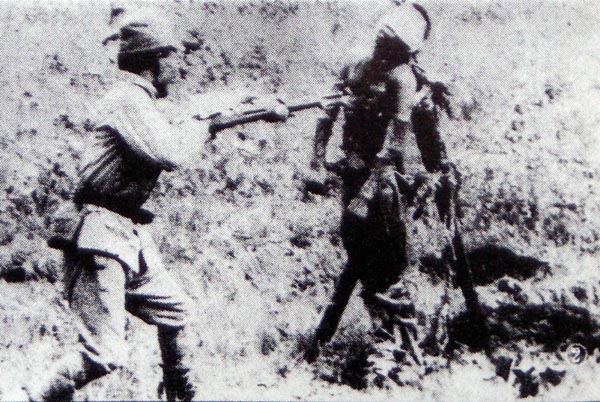
In the fall of 1937, the Associated Press (AP) distributed this photo
as a Japanese soldier using a Chinese national as a guinea pig for bayonet
practice. Iris Chang’s The Rape of
Nanking carries the same kinds of photos of Japanese atrocities. However,
the soldier wears a turned-down-collared uniform, which no Japanese soldier
wore at that time, so the man is not a Japanese soldier. The January 1939
issue of Lowdown, an American magazine, commented about these photos
that this was in fact a communist Chinese officer torturing a Chinese
prisoner.
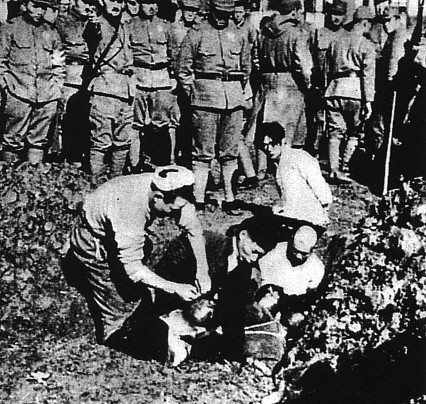
This photo is explained as Chinese people buried alive by the Japanese as a
part of the Nanking Massacre. However, the Japanese soldiers are not
threatening the Chinese with guns. The Chinese look like they are going in
willingly. And the color of true Japanese military gaiters were similar to
their uniforms, whereas the gaiters in the photo are rather white—the color
of Chinese military gaiters. Also, the size of each person is unnatural.
Professor Higashinakano concludes that this was a
composite of plural photos.

This is not a photo of Japanese soldiers but Chinese soldiers buring Chinese civilians. The idea of buring
civilians alive was not Japanese but Chinese.
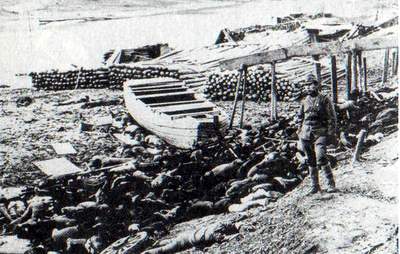
This photo was identified as Nanking Massacre victims on the shore of the
Yangtze River, but these bodies were the Chinese soldiers who died in battle,
not a massacre. Hashimoto, a Japanese soldier who fought there, testified,
“The Chinese soldiers carried their rifles or machine-guns but none of them
were in regular military uniform.” Sekiguchi also testified, “None of them
showed signs of surrender.” Thus, the Japanese army had to continue to attack
them and many of the Chinese soldiers were shot or drowned in the river. In
this photo are the bodies that were washed up on shore.
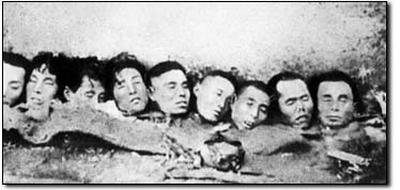
This photo is used as purported evidence of Nanking Massacre victims, but
there was no such custom of gibbeted heads among the Japanese after the
1870s. Among the Chinese, however, this custom was still observed in the
1930s, and several photos of gibbeted heads appeared in cities of China
in those days. Chinese Nationalists and Communists often killed pro-Japanese
Chinese people and gibbeted their heads on streets as a warning. Iris Chang’s
The Rape of Nanking has the same
photo with a larger background behind the heads on page 113. Looking at the
photo, those who had experienced Nanking testified that the background is not
of Nanking.
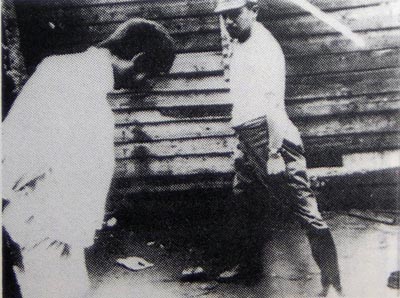
This photo was identified as a Japanese soldier executing a Chinese. However,
the alleged Japanese soldier is swinging the sword down with one hand. This
is indeed Chinese way. The Japanese never swing a sword down with one hand,
but with both hands. It is clear that this was a Chinese prearranged
performance. The man with the sword appears in other forged photos, also.

This photo is used as purported evidence of infant victims of the Nanking
Massacre and is displayed at the Nanking
Massacre Memorial
Museum in China. However, this photo was
not taken in Nanking, for the photo is from a postcard sold in China in war
days as the one taken at Tiyelien in Manchuria.
There was no custom of slaughtering infants even of the enemy throughout
Japanese history, although this custom frequently appears in Chinese
chronicles. Denialists suggest that this photo is in fact a picture of
victims of Chinese civil war.
It is well known in Japan
that General Iwane Matsui of the Japanese army saved from the battle a
Chinese infant who was found crying. He let his subordinate carry the child
on his back when marching into Nanking,
named her Matsuko, and continued to nurture the child.
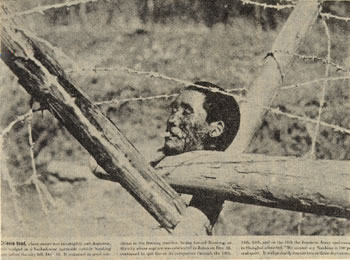
This photo of a gibbeted head appeared in Life
magazine on January 10, 1938. The caption stated that the head was of an
anti-Japanese Chinese man and had been placed there on “Dcember
14, just before the fall of Nanking.” However, December 14 was not before the fall
of Nanking. The caption also gives the
impression that the Japanese military were responsible for this atrocity, but
in China
there were a lot of cases of gibbeted heads due to personal hatred or civil
war, and there is no positive proof that the Japanese were responsible for
these acts.
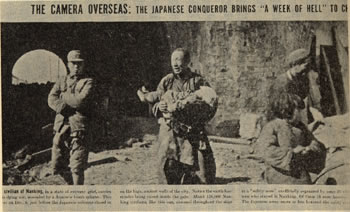
This photo from Life magazine on
January 10, 1938, was taken on December 6, 1937 and explained as a Chinese
man carrying his son who had been wounded in the Japanese bombing. This was
not a photo after December 13, 1937, the day of the fall of Nanking.
The soldier on the left wears a cap that looks Chinese. The movie, Battle of China, and others, used this
photo as a depiction of the Nanking Massacre.
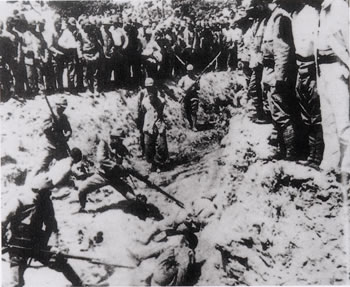
Purported evidence of a Japanese public execution in Nanking.
However, the surrounding people wear summer clothes, so this photo is not
related to the Japanese occupation of Nanking,
which took place in winter. There was no custom of public execution in Japan after the 1870s, although it remained in
China
in the 1930s. Denialists allege that this was a prearranged pose set up by
the Chinese for propaganda purposes.
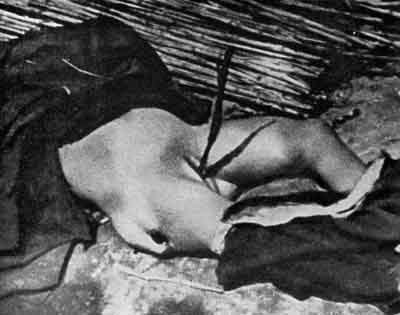
This photo is explained as an old woman who was killed by the Japanese
military and skewered with a pipe thrust into her vagina, without proof that
the criminal was really Japanese. This photo has no accompanying reliable
information about the evidence: who judged it and how. This kind of killing
by skewering was a Chinese practice frequently seen among the Chinese in
those days and in Chinese chronicles—not among the Japanese.
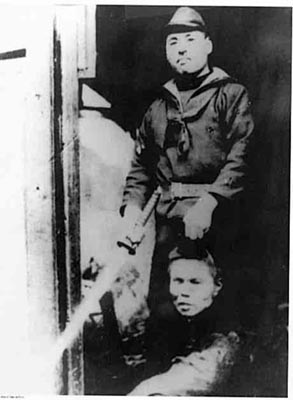
This photo is described as a Japanese sailor after beheading and used to show
a Japanese atrocity. However, the uniform of the man with a sword is
different from a Japanese sailor’s. And, if we look closer, the severed head
is so short-haired that the standing “sailor” could not possibly hold it up
by grabbing its hair. In addition, the part under the severed head is
blackened, which may cause us to speculate that this was actually a
touched-up photo of a live man with the area around his head blackened sitting
next to the sword-holding man. Denialists allege that this was a prearranged
pose set up by the Chinese for propaganda purposes.
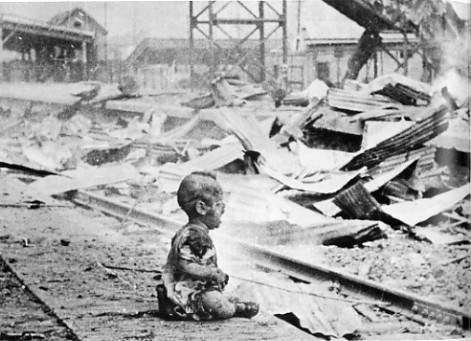
This photo was taken in the ruins of Shanghai
by H.S. Wang, a Chinese American photographer, and first appeared in Life magazine on October 4, 1937. This
became one of the most influential photos to stir up anti-Japanese feeling in
the USA,
and is still used to show Japanese atrocities in relation to the Nanking
Massacre. However, a correspondent of the Chicago
Tribune News Service later presented other photos taken at the same hour
and same place showing evidence that this had been a staged photo: the baby
was brought there by the photographer to create a dramatic photo.
Lies and Propaganda
These forged photos
above were distributed by the Chinese Nationalist Party propaganda bureau to
enlist the support of the United States for their war against Japan. Theodore
H. White, who had been an adviser to the Chinese propaganda bureau,
confessed, “It was considered necessary to lie to it [the United States], to deceive it, to do anything to persuade America. . . . That was
the only strategy of the Chinese government. . . .” (In Search of History: A Personal
Adventure)
Historians say that the Chinese chronicles were the
history of those who deceived and of those who were deceived. The alleged
Nanking Massacre was one of their deceiving means.
See
more fake photos
|
The So-Called Nanking Massacre
was a Fabrication
The Japanese Military in Nanking (Nanjing) was Humane
The alleged massacre, which was said to have been
committed
by the
Japanese Military in Nanking, China, did not take place.
Those who committed atrocities were Chinese soldiers.
Reverend
Arimasa Kubo
(Japanese Christian pastor and non-fiction writer)
What is the Alleged Nanking
Massacre?
The alleged Nanking
Massacre, commonly known as the Rape of Nanking, is the name of a genocidal
war crime said to have been committed by the Japanese military in the city of
Nanking, the then capital of the Republic of China, after it fell to the
Imperial Japanese Army on December 13, 1937. There is a dispute about whether
it really occurred or not.
Massacre affirmationists claim that during the
occupation of Nanking, the Japanese army committed numerous atrocities such
as rape, looting, arson and the execution of prisoners of war and civilians.
They say that the Japanese massacred about 300,000 Chinese people in Nanking
during the six weeks after the Japanese occupation of the city. On the outer
wall of the Nanking Massacre Memorial Museum in China is written “300,000” as
the number of the massacre victims. Many Chinese children visit there every
year to be planted anti-Japanese feeling in their hearts.
Massacre denialists claim that newspapers, photos, documentary films, records
and testimonies in those days all tell the Nanking Massacre of 300,000 people, a large-scale massacre or even a
small-scale massacre, did not take place. According to denialists, the
so-called Nanking Massacre was a fabrication and false propaganda spread
by Chinese Nationalists and Communists for their political purpose.
Today, we have numerous reliable pieces of evidence showing that the massacre
did not actually occur. Firstly, I will give a brief explanation of what
actually occurred in Nanking, and then, show the details.
What Actually Occurred in Nanking
At the Battle of Shanghai in
1937, when the Chinese military of more than 30,000 soldiers attacked the
Japanese settlements in Shanghai, many people were killed, not only Japanese,
but also many Chinese and Westerners. That was the beginning of the Sino-Japanese
war. To stop the Chinese attack and the war, Japan decided to occupy Nanking,
the then capital of the Republic of China. During the battle, every civilian
who remained in Nanking took refuge in the Safety Zone, which was specially
set up within the walls of the city. The Japanese military did not attack it,
and no civilian was killed.
Until the time of the Japanese occupation of Nanking, the Chinese military
had committed numerous bad deeds such as plunder and rape among citizens. The
citizens who had abhorred them welcomed the entry of the Japanese military
into Nanking, giving cheers and rejoicing (see the picture at the top of this
page).
Just before the Japanese occupation, the population of the city was about
200,000. One month after the
occupation, many Chinese citizens came back to Nanking learning that peace
had returned, and the population increased to about 250,000. Newspapers
in those days had numerous photos of Chinese citizens who had come back to
Nanking and lived peacefully, buying, selling and smiling with Japanese
soldiers.
In the battle of Nanking, many Chinese
soldiers discarded their military uniforms to run away, killed Chinese
civilians to take off civilian clothes, and hid themselves among Nanking
citizens. Espy, the American vice-consul at Nanking, and others witnessed
these scenes. Those who massacred
Chinese people were in fact Chinese soldiers. The Chinese military in those days was rather a crowd of robbers, than
to be called a disciplined military. They plundered Chinese villages of
foods, raped women and burnt the villages. Civilians who were killed in and
around Nanking were mostly killed by the Chinese military. There are many
testimonies and evidence about it.
Furthermore, many of the Westerners, who took care of the Nanking
Safety Zone, sheltered Chinese military officers secretly, breaking the
agreement with the Japanese military to be neutral. Many of the Chinese soldiers raped
Chinese women at places, and did many other atrocities, putting them on an
act of the Japanese military.
The Westerners in Nanking repeatedly reported the alleged Japanese
atrocities, such as numerous rapes, killings and robberies to Western
countries (especially
to the USA) until January 4,
1938, for the Westerners had ever believed the atrocities were done by the
Japanese; however, on that day, the Chinese soldiers whom the Westerners had
sheltered were arrested by the Japanese military. The Westerners were so
embarrassed to see the Chinese soldiers confessing that they had done
those atrocities, and had blamed the Japanese military for their attacks.
The
New York Times reported it.
The same arrests
of Chinese soldiers took place on Jan. 25 and Feb 17, 1938, etc. After
those, the atrocities in Nanking stopped. People in Nanking got peace and
order. Most of the Westerners, too, stopped talking about Japanese
atrocities. Thus, the Chinese soldiers whom the Westerners sheltered were in
fact doing such atrocities in Nanking. The sheltered Chinese soldiers also had
told lies to the Westerners that the Japanese were doing various
atrocities at places, and the Westerners, believing their lies, had reported
those to the US, etc., and provoked strong anti-Japanese feelings there.
These
Westerners’ reports are often referred to still today as the evidence of
Japanese atrocities. However, they were thus not the evidence of Japanese
atrocities, but the evidence of the Chinese atrocities and their
anti-Japanese maneuverings. Other than those Chinese soldiers whom the
Westerners sheltered, there were also many other Chinese soldiers hiding in
the Nanking Safety Zone, wearing civilian clothes and hiding weapons to
prepare urban warfare. The Japanese military found out and arrested these
illegitimate soldiers. Rebellious ones were executed by the Japanese
military; however, these executions were recognized as legitimate under
international law.
It is also a fact that there were around ten or several tens cases of small
crimes such as plunder and rape committed by Japanese soldiers in Nanking.
However, these were similar to the crimes which soldiers of other countries
also committed in occupied territories, and the Japanese criminals were
strictly punished.
There were such things, but the Japanese military did not massacre anyone in
Nanking. The Japanese military rather
did many humane aid activities to Nanking citizens and POWs. There was no
single Chinese citizen who starved to death under the Japanese occupation.
Seeing these Japanese activities and being moved by them, there were even
Chinese POWs who later joined Wang Jingwei’s pro-Japanese government.
The following are the details.
********************
Evidence that the Japanese Military Did Not Massacre
Return of the Populace
The population of Nanking just before the Japanese occupation was
about 200,000. About a week before
the Japanese attack on Nanking, on November 28, 1937, the head of the Police
Department of Nanking, Mr. Wan, announced at a press conference for
foreigners, “About 200,000 people still live here in Nanking.” Five days
after the Japanese occupation, on December 18, 1937, the International
Committee for the Nanking Safety Zone, which was a group of Westerners
remaining in Nanking, announced that the population of the city was about 200,000.
Later, on December 21, the Foreigners Association in Nanking referred to
200,000 as the population of Nanking.
How could the
Japanese kill 300,000 citizens in a city that held only 200,000 people?
One month after
the Japanese occupation, many Nanking
citizens who had escaped the city came back to Nanking, learning that
peace had returned, and the population increased to about 250,000. There is a
record that the Japanese troops distributed food to that number of citizens.
On January 14, 1938, about one month after the Japanese occupation, the
International Committee announced that the population of Nanking had increased to about 250,000.
The
Japanese military had published Good
Citizen Certificate to Nanking citizens from the end of December
1937 to January 1938 to distinguish them from Chinese soldiers hiding in
Nanking in civilian clothing. The total number of the certificates reached
about 160,000, although this figure does not include children under the age
of ten and old people above the age of sixty. Professor Lewis Smythe, who was
in Nanking as a member of the International Committee for the Nanking Safety
Zone, wrote in his letter to Tokuyasu Fukuda, a
probationary diplomat of the Japanese Embassy in Nanking, that according to
this figure, the population of Nanking was about 250,000-270,000.
Many Nanking
citizens thus came back to the city, and the population increased. Would the
citizens have come back to a city in which there had been a massacre?
Press Reports
On the day when the Japanese
troops entered Nanking, more than 100 press reporters and photographers
entered together with them. The press corps were not only from Japan, but
also from European and American press organizations, including Reuters and
AP. However, none of the press corps reported the occurrence of a massacre of
300,000 people. Paramount News (American newsreels) made films reporting the
Japanese occupation in Nanking, but did
not report the occurrence of a massacre.
The British newspaper North China Daily
News, which was published in China in English on December 24, 1937,
eleven days after the Japanese occupation of Nanking, carried a photo taken
in Nanking by their photographer. The photo was entitled “Japanese distribute
gifts in Nanking.” In the photo are Japanese soldiers distributing gifts, and
Chinese adults and children receiving the gifts and rejoicing. Is this the
scene of a massacre?
Radio Addresses
The Chinese leader Chiang Kai-shek,
who had escaped from Nanking just before the attack by the Japanese military,
broadcasted radio addresses hundreds of times to the Chinese people until the
end of the Pacific War. He never
mentioned the Nanking Massacre even once. This is very unnatural—if the
mass slaughter really occurred.
Newspaper Photos
At the time of the Japanese
occupation of Nanking, a major Japanese newspaper, Asahi Shimbun, published many photos of Nanking. Five days after
the occupation the newspaper reported on the peaceful scenes of Nanking. In one of the photos, Japanese
soldiers are buying something from a Chinese without carrying their guns. In
another photo, Chinese farmers who returned to Nanking are cultivating their
fields. In others, a crowd of Chinese citizens are returning to Nanking
carrying bags, and Chinese adults and children wearing armbands of the flag
of Japan are standing around a street barbershop and smiling.
The Asahi Shimbun also reported
scenes of Nanking eight days after the occupation in an article entitled, “Kindnesses to Yesterday’s Enemy.” In
one of the photos, Chinese soldiers are receiving medical treatment from
Japanese army surgeons. In another, Chinese soldiers are receiving food from
a Japanese soldier. In other photos, Japanese soldiers are buying goods at a
Chinese shop, a Japanese officer is talking with a Chinese leader across a
table, and Chinese citizens are shown relaxing. Are these the scenes of a
massacre? Articles from other dates are similar, reporting that peaceful
Chinese living returned to Nanking. Many Chinese civilians came back to the
city; farmers began to cultivate their fields and merchants began to do
business again. How can we say there was a massacre in the city?
The sources of these photos are very clear. They can be seen at the National
Diet Library of Japan. We cannot deny that they were taken in Nanking just
after the Japanese occupation.
The Japanese Military Did Not Attack Civilians
Before the battle of
Nanking, the commander General Iwane Matsui ordered the Japanese army to be
very careful not to kill any civilians.
During the battle, every civilian took refuge in the Nanking Safety Zone,
which was specially set up to protect all the civilians of Nanking. The
Japanese army knew that many Chinese soldiers were also in the Zone;
nevertheless, the army did not attack it, and there were no civilian victims,
except for several who were accidentally killed or injured by stray shells.
This Nanking Safety Zone was managed by the International Committee for the
Nanking Safety Zone, which was a group of professors, doctors, missionaries
and businessmen from Europe and the USA. They did not leave Nanking before
the beginning of the battle, but chose to remain in the city. The leader of
the Committee was John Rabe, and after the Japanese occupation, he handed a letter of thanks to the commander of
the Japanese army. The following is an excerpt from his letter of thanks:
December 14,
1937
Dear commander of the Japanese army in Nanking,
We appreciate that the artillerymen of
your army did not attack the Safety Zone. We hope to contact you to make
a plan to protect the general Chinese citizens who are staying in the Safety
Zone. We will be pleased to cooperate with you in any way to protect the
general citizens in this city.
--Chairman of the Nanking International Committee, John H. D. Rabe--”
If the Japanese
military wanted to massacre every Nanking citizen, it would have been very
easily done if they only bombarded the Nanking Safety Zone, because it was a
narrow area and all civilians gathered there. The Japanese military did not
attack it, but rather protected all the people of the Zone.
The reason why the Japanese military attacked Nanking was similar to the
reason why the American and the allied militaries once attacked Baghdad of
Iraq at the Gulf War in 1991. The alliance wanted to get rid of the Iraqi
dictator who was doing bad things to neighboring countries. Similarly, Japan
wanted to get rid of Chiang Kai-shek’s dictatorship which was giving torments
to many Chinese people and also to Japan. General Matsui’s purpose of the war
was not to take the land, but to save Chinese civilians from his dictatorship
and from the Chinese civil war, killing among the Chinese themselves. Japan
wanted to establish in China a strong Chinese government not of communists,
not of Western powers, but of the Chinese people who were willing to build in
cooperation with Japan the great Asia which
would not be invaded by communists or exploited by Westerners. It was
impossible for such Japanese military to kill Chinese civilians.
Traditionally in Japan, Samurai warriors lived inside walls of castle, and
inhabitants like farmers and merchants lived outside the walls. Civilian
cities were not walled. War was a fight only among warriors, and they never
killed civilians. If a Samurai killed innocent civilian either in his land or
enemy’s land, the Samurai’s lord blamed him as against the Samurai spirit,
and punished him. While, in China, inhabitants like farmers and merchants
lived inside a walled city, and in wars the inhabitants inside were often all
slaughtered along with warriors. In Chinese chronicles, we often read such
massacres. The Chinese language has the word which writes slaughtering castle
and means slaughtering all people within the city. It was a Chinese culture.
The Japanese never had such a culture. Nanking was a walled capital city, and
the idea of massacring all inhabitants was Chinese, not Japanese.
Total Number of Buried Bodies
After the
battle of Nanking, the Japanese military entrusted the burial of the war dead
to the Chinese.
The International Military Tribunal for the Far East (Tokyo Trial) used the
burial records of about 40,000 bodies
by the Red Swastika Society, a Chinese voluntary association in Nanking,
as evidence of killings of the Japanese military. The Tribunal also used the burial records of 112,267 bodies by the
Chung Shan Tang (Tsung Shan Tong), a 140-year-old charitable organization.
The combined total was about 155,000.
However, concerning the Chung Shan Tang, none of the documents which were
written by members of the International Committee in Nanking or the Japanese
authorities in Nanking mentioned that the Tsun Shan Tang was engaged in the
burial work. Kenichi Ara, a researcher of modern history, showed evidence in
an article of the Sankei Shimbun newspaper that the Chung Shan Tang’s
burial report of 112,267 bodies had been entirely forged and that they had
actually buried no bodies. The Chung Shan Tang’s report was a false one added
after the war to amplify the number of burials.
It was a fact that the Red Swastika Society engaged in the burial work. They
buried almost all the war dead in Nanking, and according to the Society, the
burials reached about 40,000. This is far from 300,000. In addition, these
40,000 were killed in battle, not in a massacre, because among the bodies were almost no corpses of women and children. This means that the Japanese military did
not massacre civilians. I will mention the details later.
Denial of Massacre in Testimonies
Shudo Higashinakano,
a professor at Asia University in Tokyo, published a compilation of the
testimonies of Japanese soldiers who had participated in the Nanking
operation in his book entitled, The
Truth of the Nanking Operation in 1937. In these testimonies, no Japanese
soldiers testified that there had been a massacre. For instance, Colonel Omigaku Mori stated, “I have never heard or seen any massacre in Nanking.”
Kenichi Ara, a researcher of modern history, published a compilation of the
testimonies of Japanese press reporters, soldiers and diplomats who had
experienced Nanking during the Japanese campaign. In these testimonies, also,
no one testified that there had been a massacre of civilians. Yoshio
Kanazawa, a photographer from the Tokyo
Nichinichi Shimbun newspaper, testified, “I
entered Nanking with the Japanese army and walked around in the city at
random every day, but I have never
seen any massacre nor heard it from soldiers or my colleagues. It is
impossible for me to say that there was a massacre. Of course, I saw many
corpses, but they were those killed in battle.”
Tokuyasu Fukuda, who was in Nanking as a Japanese
diplomat, testified, “It is a fact that there were crimes and bad aspects of
the Japanese military, but there was
absolutely no massacre of 200,000-300,000, or even 1,000 people. Every
citizen was watching us. If we had done such a thing (massacre), it would be
a terrible problem. Absolutely it is a lie, false propaganda.”
Kannosuke Mitoma, a press
reporter of the Fukuoka Nichinichi Shimbun newspaper, worked as the head of
the Nanking branch office at the time of the Japanese occupation. In those
days his daughter attended the Japanese elementary school in Nanking (from
the first grade to the fifth). She testified, “I used to play with neighboring Chinese children in Nanking, but I
have never heard even a rumor of the massacre.”
Humane Activities and Fellowship in Nanking
A chief of infantrymen
testified, “We defeated the enemy and saw thousands of them dead on the
ground of Nanking. But finding a Chinese soldier still alive, our captain
gave him water and medicine. The Chinese soldier folded his hands and said
“Xie xie” (Thank you) with tears welled up in his
eyes. In this way, our infantry
company saved 30-40 Chinese soldiers and let them go home. Among them
were many who cooperated with us and worked for us. When they had to part
from us, they were reluctant to leave, shed tears and then went home.”
A sergeant major of infantrymen testified, “On the way to Nanking, I was
ordered to stand as a guard having a rifle one night when I noticed a young
Chinese lady in Chinese dress walking toward me. She said in fluent Japanese,
‘You are a Japanese soldier, aren’t you.” And she continued, ‘I ran away from
Shanghai; other people were killed or got separated and I thought it would be
dangerous for me to be near the Chinese military, so I’ve come here.” “Where
did you learn Japanese?” said I, and she said, “I graduated from a school in
Nagasaki, Japan, and later, worked for a Japanese bookstore in Shanghai.” We
checked but there was nothing suspicious on her. And since we did not have
any translator, we decided to hire her
as a translator. She was also very good at cooking, knowing Japanese
taste, and turned on all her charm for all of us, so we made much of her. She
sometimes sang Japanese songs for us, and her jokes made us laugh. She was
the only woman in the military unit but made our hard march pleasant. Before
the beginning of our attack to the city of Nanking, the commander made her
return to Shanghai.”
A first lieutenant testified, “When we had just entered the Nanking Safety
Zone, every woman was dressed in rags with her face and all her skin dirtied
with Chinese ink, oil or mud to appear as ugly as possible. But after they got to know that the Japanese
soldiers were strictly maintaining military discipline, their black faces
turned to natural skin, and their dirty clothes turned to fine ones. Soon, I
became to come across beautiful ladies in the streets.”
Another soldier testified, “When I was washing my face in a hospital in
Nanking, a Chinese man came to me and said, “Good morning, soldier,” in
fluent Japanese. He continued, “I was in Osaka for 18 years.” I asked him to
become a translator for the Japanese army. He later went to his family, came
back and said, “I told my family, ‘The Japanese army have come. So, you are
now all safe.’” He cooperated
faithfully with the Japanese army for 15 months until we reached Hankou.”
If there had been a massacre of civilians in Nanking, it would have been
impossible for the Chinese man to work for the Japanese.
Naofuku Mikuni, a press reporter, testified, “Nanking citizens were generally cheerful
and friendly to the Japanese just after the fall of Nanking, and also in
August 1938 when I came back to Nanking.” He points out that if the Japanese
crime rate was very high, such cheerfulness would not have been seen in the
city.
Not only these Japanese persons, but also James McCallum, who was in Nanking as an American medical doctor,
wrote in his diary on December 31. 1937, “Today I saw crowds of people
flocking across Chung Shan [Zhongshan] Road out of the Zone. They came back
later carrying rice which was being distributed
by the Japanese from the Executive Yuan Examination Yuan.”
McCallum also wrote, “I must report a good deed done by some
Japanese. Recently
several very nice Japanese have visited the hospital. We told them of our
lack of food supplies for the patients. Today they brought in 100 shing [jin (equivalent to six kilograms)] of beans along with
some beef. We have had no meat at the hospital for a month and these gifts
were mighty welcome. They asked what else we would like to have.”
Are these the scenes of a
city in brutal massacre?
Chinese Soldiers Discarded Military Uniforms
Mochitsura Hashimoto, a Japanese soldier who fought
in the battle of Nanking near the Yangtze River, testified, “Though the
Chinese soldiers carried their rifles or machine-guns, none of them were in
regular military uniform.” Other veterans testified, “None of them showed
signs of surrender.” Therefore, the Japanese army had to continue to attack
them, and many of the Chinese soldiers were shot or drowned in the river.
However, pictures of these dead
soldiers in civilian clothing—who had been killed in battle—were later
used in the Western world as “evidence of the massacre of civilians.”
Many of the Chinese soldiers in Nanking discarded their military uniforms,
and became “illegitimate” combatants. F. Tillman Durdin, an American News
correspondent, wrote in his article in the New York Times on December 22, 1937, “I witnessed wholesale undressing of a [Chinese] army.... Many men
shed their uniforms.... Others ran into alleys to transform themselves into
civilians. Some soldiers disrobed completely and then robbed civilians of
their garments.” Durdin also wrote that Chinese soldiers who reached the
Yangtze River tried to escape using junks, but “many were drowned in periods
of panic at the riverbank.”
Japanese veterans testify that, when they entered Nanking, they saw
throughout the city piles of Chinese military uniforms that had been taken
off and abandoned on the ground.
Among the Chinese soldiers who discarded uniforms, those who ran away from
the battle fields were killed by the Japanese military, or by a “Chinese supervisory unit”—Chinese
soldiers who were ordered to kill any of their fellow soldiers trying to flee
from the battlefield. The US military and the Japanese military do not have
such a unit, but Chinese soldiers trying to escape from battle field were
killed by the supervisory unit who was waiting behind. These killed ones did
not wear military uniforms, but they were actually soldiers.
There were also Chinese soldiers who discarded military uniforms and killed
Chinese civilians to obtain civilian clothing and to hide themselves among
citizens. James Espy, the American vice-consul at Nanking, reported to the
American Embassy at Hankow concerning conditions before the fall of Nanking,
writing, “During the last few days some
violations of people and property were undoubtedly committed by them [Chinese
soldiers]. Chinese soldiers in
their mad rush to discard their military uniforms and put on civilian
clothes, in a number of incidents, killed
civilians to obtain their clothing.”
The Chinese military was basically a scratched-together army of hooligans,
having no military discipline or concept of international law. They were the
same as bandits. They did not protect Chinese civilians, but rather plundered
of them, set fire to houses, raped women and killed civilians. They did these
things also in Nanking, as we will see the details later.
Miner S. Bates and His Incorrect Reports
The first source who
reported the so-called "Nanking Massacre" to the world was not a
Chinese, but an American who was a supporter of the Chinese Nationalists.
Miner S. Bates (1897-1978), who was in Nanking as a leading member of the
International Committee for the Nanking Safety Zone. He wrote on January 25,
1938:
“Evidence from
burials indicates that close to forty thousand unarmed persons were killed
within and near the walls of Nanking, of whom some 30 percent had never been
soldiers.”
The number of
the massacre victims was thus first claimed as about 40,000, not 300,000. The
number 300,000 is a so-called "Chinese figure," which means
enlarged.
Bates is still
told in the US as if he were a hero who protected Nanking civilians from the
Japanese massacre; however, it was not a fact. Bates was publicly a Christian
missionary and a university professor in Nanking; but in fact, it turned out
after the war that Bates had been an adviser to the Chinese Nationalist
Party. Bates was a part of the Chinese propaganda about how bad the Japanese
were. Bates was later decorated by Chiang Kai-shek for his
"contribution," for he himself wrote so in his personal history.
As I mentioned
earlier, the International Committee members living in Nanking repeatedly
blamed the Japanese military for many atrocities, such as rapes and lootings,
but those were actually committed by the Chinese soldiers harbored by the
members. On the other hand, only Bates reported the alleged Japanese
mass-killings of Nanking civilians.
Even the
spokesman of the Chinese nationalist party never mentioned the Japanese
massacre at their 300 times press interviews at Hankou for one year after the
Japanese occupation of Nanking. Bates was thus the only man who was eager to
try to insist the Nanking Massacre. The people who were or once were in
Nanking did not see any Japanese mass-killings of civilians, but it was
possible for Bates to let the people outside Nanking believe there had been
that massacre.
Different from
James Espy, who reported the Chinese atrocity of killing many civilians to
take civilian clothing, Bates never reported such a Chinese atrocity. He only
testified the Nanking Massacre allegedly committed by the Japanese. We have
to think that Bates' report was very biased, for he was secretly acting as a
part of the Chinese propaganda to spread how bad the Japanese military was.
Was the Nanking
Massacre that Bates insisted true? No. Firstly, Bates’ report of "40,000
unarmed persons were killed" was incorrect. That was his mistake or
willful lie. The number 40,000 was from the burial list of the Red Swastika
Society, a Chinese group, who buried almost all of
the war dead under the request of the Japanese military. According to the
list, they buried close to 40,000 bodies. This was the total number of all
who were killed in Nanking, except Japanese soldiers. Most of the bodies were
of armed Chinese soldiers, not “unarmed persons.”
In fact, in April 1938, that was four months after the
Japanese occupation, an officer from the Embassy of the United States in
Tokyo visited Nanking to hear from Bates detailed information about the
Japanese occupation. However, Bates did not say any word about the massacre,
for Bates could not tell about the massacre to the man who actually saw the
peaceful scenes of Nanking.
Bates also could
not prove the Japanese massacre of civilians when he was required to show
proof by Consul John M. Allison. There are many such things about Bates.
Prof. Shudo Higashinakano
of Asia University, who inquired the details, wrote, "I can't help being
surprised of Bates’ double-tongues."
Secondly, Bates
claimed, “some 30 percent (of the 40,000) had never been soldiers.” However,
Professor Tadao Takemoto (Tsukuba University) and Professor Yasuo Ohara (Kokugakuin University) point out that the "evidence
from burials" of the Red Swastika Society in fact contains only 0.3
percent of women and children. The burial list has the distinction of sex and
rough age. If the Japanese military killed many civilians, the percentage of
women and children must have been very high, yet it was actually almost none.
That means, the 40,000 bodies were armed Chinese soldiers, not civilians.
Bates’ Testimony: Truth or Lie?
Miner S. Bates also testified in the Tokyo Trial after World War II that he
had seen many civilian dead bodies lying about everywhere in his neighborhood
for many days in Nanking after its fall. Did he tell a fact?
No. According to
the Japanese newspaper Tokyo Nichinichi Shimbun on December 26, 1937, which
reports when correspondents Wakaume and Murakami
visited Professor Bates at his official university residence on December 15,
two days after the fall of Nanking, Bates welcomed them in a good humor,
shook hands with them and said, “I am so happy that the orderly Japanese
military entered Nanking and peace has been restored to the city.” The
correspondents did not see in his neighborhood the “…many civilian dead bodies
lying about everywhere,” which Bates testified to have seen.
Yuji Maeda, a Domei Tsushin
correspondent who spent days in the Nanking Safety Zone like Bates did,
denies that there were massacred bodies as follows: “Those who claim that a
massacre took place in Nanking assert that most of the victims were women and
children. However, these supposed victims were, without exception, in the
Safety Zone and protected by the Japanese Security Headquarters. The Nanking
Bureau of my former employer, Domei Tsushin, was
situated inside the Safety Zone. Four
days after the occupation, all of us moved to the Bureau, which served both
as our lodgings and workplace. Shops had already reopened, and life had returned to normal. We were
privy to anything and everything that happened in the Safety Zone. No massacre claiming tens of
thousands, or thousands, or even hundreds of victims could have taken place
there without our knowing about it, so I can state with certitude that none
occurred. Chinese soldiers were executed, some perhaps cruelly, but those
executions were acts of war and must be judged from that perspective. There
were no mass murders of non-combatants.”
(World and Japan magazine issued by Naigai News Agency, #413,
April 5, 1984)
Not only these correspondents, but also Japanese veterans and other press
reporters testify that they did not see any massacred civilians in Nanking.
Correspondent Kondo of the Asahi
Shimbun newspaper testified about his experience in Nanking, “There was a
fierce battle at the Guanghua Gate. I saw corpses of both Chinese and
Japanese soldiers there, but I did not see any civilian corpses.”
Jiro Nimura, a Mainichi Shimbun
photographer, testified, “I climbed up a wall of Nanking and entered the city
with the 47th regiment. Inside the walls I saw only a few dead bodies.” And
Isamu Tanida, a staff officer of the 10th Army, testified, “On December 14,
the city was already quiet and I heard no shots there. In the afternoon I
walked around in the city taking some pictures, when I saw a few corpses of
Chinese soldiers only.”
A veteran of the 7th Regiment, which was assigned to sweep the Safety Zone,
testified that the regimental command had been, “Don’t kill citizens. Don’t dishonor the army,” and they had
followed this command. He testifies, “Absolutely there was no massacre.”
Thus, nobody saw the alleged massacred civilians inside the Safety Zone, as
well as outside it.
All the honest witnesses thus did know that there was no massacre by the
Japanese in Nanking. But only Bates, who was an adviser to the Chinese
Nationalist Party, was acting as a part of the Chinese lie that the Japanese
military was so bad.
Information Source of Durdin’s
Report
Miner S. Bates was an
information source for the press also. On December 18, 1937, the American
correspondent F. Tillman Durdin wrote in the New York Times, “all the alleys and streets were filled with
civilian bodies, including women and children.”
However, this
article was not what Durdin himself witnessed, for Durdin wrote, “Foreigners
who toured the city and saw that all the alleys and streets were...” Durdin
thus wrote what he had heard. Who were the “foreigners”? They were Rabe,
Bates, and other International Committee members; however, no one in Nanking
actually saw such civilian corpses in alleys and streets. So didn’t Durdin.
Durdin in fact wrote this article based on what he had heard from Bates, for
Bates drove Durdin to the harbor on December 15 to see him off, and Durdin
got on board a ship and left Nanking at 2:00 p.m. Bates later wrote in a
letter of April 12, 1938, that he had
given a memo about the incidents of Nanking to Durdin and other
correspondents on December 15. Durdin’s article was written according to this
memo that Bates handed him. Bates was a source of false information on the
alleged massacre of civilians in Nanking.
In 1938, the book entitled What War
Means written by H.J. Timperley was published. Timperley, who was not in
Nanking, but in Shanghai, wrote in the book sensationally about the massacre
of Nanking civilians. This book is famous for having given a strong influence
to the US public opinions. The information source of Timperley’s book was
also Bates, for Timperley wrote so in the book.
Timperley was
paid by the Chinese Nationalist Party. Zeng Xubai,
the chief of the China Information Committee, writes in his autobiography:
“Timperley was
an ideal man. Thus, we decide that our first step would be to make payment to
Timperley, and also through his coordination, to Smyth, and commission both
of them to write and publish two books for us as witnesses to the Nanking
Massacre…..We held discussions with Timperley, and he became our secret man
in charge of propaganda in America”
Bates and
Timperley in partnership were thus eager to drag the United States into their
war against Japan by telling how bad Japan was. Concerning the strategy of
the Chinese Nationalist Party, American journalist Theodore H. White, who had
been an adviser to the Chinese Nationalist propaganda bureau, confessed:
“It was considered necessary to lie to it [the United States], to deceive
it, to do anything to persuade America. . . . That was the only strategy
of the Chinese government. . . .” (In Search of History: A Personal Adventure)
Chinese Soldiers Killed by Chinese Supervisory
Units
The American correspondent
F. Tillman Durdin reported in the New
York Times that he had witnessed on December 15 a lot of bodies of dead
Chinese soldiers forming a small mound six feet high at the Nanking Yijiang gate in the north.
Concerning this mound of Chinese dead, Professor Tokushi
Kasahara interviewed Durdin on August 14, 1987. Durdin stated that the mound had been formed before the
Japanese military reached there, and that the Chinese soldiers had not
been killed by the Japanese military. He said, “The bodies were Chinese
soldiers who tried to escape.... I think that the mound of bodies had been
formed before the Japanese military occupied there. In that area there was no
combat of the Japanese military.”
According to
Professor Higashinakano, the bodies witnessed by
Durdin had been killed by the Chinese
supervisory unit that had been waiting behind to kill Chinese soldiers
trying to escape from the battlefield. The American or Japanese military
never have such a unit, but the Chinese military always had such a unit to
kill their fellow soldiers.
Professor Bunyu Ko at Takushoku
University in Tokyo estimated that throughout the Sino-Japanese war the
victims killed by such Chinese supervisory units had been more than those
killed by the Japanese military.
In Nanking also,
there were many Chinese soldiers who were killed by the Chinese supervisory
unit, not by the Japanese military. The casualties that Miner Bates and other
Committee members mentioned included such victims.
Only Legitimate Executions
When the defeat of the
Chinese military became definite in the battle of Nanking, Chinese soldiers
had three choices. The first was to surrender, and those who surrendered were
taken as POWs (prisoners of war). The second was to escape from Nanking. Those
who ran away were killed either by the Japanese military or the Chinese
supervisory unit. The third was to hide, wearing civilian clothes, in the
Safety Zone which had been specially set up inside the walls of Nanking for
civilians. Every Nanking citizen was taking refuge in the Safety Zone, and
many of the Chinese soldiers took this choice and hid themselves in the Zone.
After the fall of Nanking, the
Japanese military did a mop-up operation to find those Chinese soldiers
hiding in the Zone. Those who were caught and found hiding weapons were
executed. They were considered to have been preparing a street fighting or
guerilla activities. According to Professor Higashinakano,
the Japanese military executed several thousand such dangerous Chinese
soldiers. Some scenes of this execution were witnessed by both Western and
Japanese press reporters.
The question is whether or not the executions by the Japanese military were
legally justifiable. Legitimate combatants who have become POWs are under the
protection of international conventions, which govern their treatment. They
are immune from capital punishment unless they violate laws or regulations.
The killing of such POWs without legitimate cause would indeed constitute an
unlawful massacre. However, the
Chinese soldiers who were arrested in the Safety Zone were not entitled to
the privileges of POWs because they did not meet any of the four
qualifications of belligerents as stipulated in the Hague convention of 1907.
These four qualifications are:
1. To be commanded by a person responsible for his subordinates
2. To have a fixed distinctive emblem recognizable at a distance
3. To carry arms openly
4. To conduct their operations in accordance with the laws and customs of war
Those who did not satisfy these qualifications were deemed to be illegitimate
combatants and were not eligible for protection under international law. This
principle was upheld in the 1949 Geneva Convention on the treatment of POWs.
The execution of such illegitimate combatants was customarily practiced in
each country, and the execution was thought to be legitimate. Unfortunately,
the Chinese soldiers did not have the wit to follow this international law.
Massacre denialists thus claim that the execution of the Chinese soldiers,
who were in civilian clothing and hiding weapons, was legitimate.
The Japanese military executed these Chinese soldiers; however, the Japanese
military did not execute all the captured Chinese soldiers. They employed many of them as a labor force,
and they numbered about 10,000 by the end of February 1938. Some of them were
registered as civilians.
POWs Not Executed
Massacre affirmationists
often refer to the division commander Kesago
Nakajima’s diary, in which is written that Nakajima “thought about disposing
7,000-8,000 prisoners of war at Xianho Gate”
according to the military policy, “Accept no prisoners.” However, it was only
a plan. There are in fact records showing that the 7,000-8,000 POWs about
whom Nakajima wrote were not killed but sent to the concentration camp in
Nanking. It is also known that Kesago Nakajima was
later removed from his post because he had been found appropriating the
equipment of the residence of Chiang Kai-shek in Nanking for his own use.
The records also show that the
concentration camp received about 10,000 POWs in total, including the
prisoners sent by Nakajima. Many of the 10,000 POWs were later released, hired as coolies or sent to
the concentration camp in Shanghai. Nearly 2000 of them became soldiers for
Jingwei Wang’s pro-Japanese government. One of these was Qixiong
Liu, who had been hiding in the Nanking Safety Zone, was caught as a POW and
used as a coolie for a while. Later he became the commander of a brigade for
Wang’s pro-Japanese government.
Many Japanese soldiers testify that “Accept no prisoners” always meant “Unarm them and let them go home.”
They actually did so when there was no need to send them to a concentration
camp. Staff officer Onishi said, “They could go home walking. There never was
any military order or divisional order to kill POWs.”
Japanese Lieutenant General Yasuji Okamura once wrote his surmise based on
what he had heard from his staff officers in Shanghai. “It is true that tens
of thousands of acts of violence, such as looting and rape, took place
against civilians during the assault on Nanking.... (and) front-line troops
indulged in the evil practice of executing POWs on the pretext of (lacking)
rations.”
This description is also often referred to by massacre affirmationists;
however, Okamura was not in Nanking and his surmise was based on a report he
heard in Shanghai. Since the Westerners of the International Committee, who
were in Nanking, reported only 450 cases of atrocities such as looting, rape
and murder committed by the Japanese military, Okamura’s surmise of “tens of
thousands of acts of violence” was clearly based on an incorrect rumor.
It is a fact, as Okamura wrote, that some officers thought to execute POWs on
the pretext of lacking rations; however, the POWs were not executed after
all.
Nobody in Nanking Witnessed 300,000 Victims
Reverend John Magee, who was in Nanking before and during
its Japanese occupation for years, filmed scenes of Nanking, and the film
is often referred to in relation to the alleged Japanese atrocities. However,
Magee’s film shows no scenes of
clearly massacred victims. The captions are alleged atrocities of the
Japanese, but the movie has no scenes of Japanese soldiers executing POWs, no
scenes of thousands of dead bodies—in fact, the movie shows mostly scenes of
living people.
John Magee also wrote about some alleged Japanese atrocities; however, most
of those were hearsay. So was the famous horrible incident in the following.
“On December 13,
about 30 soldiers came to a Chinese house at #5 Hsing Lu Koo in the
southeastern part of Nanking, and demanded entrance. The door was opened by
the landlord, a Mohammedan named Ha. They killed him immediately with a
revolver and also Mrs. Ha, who knelt before them after Ha’s death, begging
them not to kill anyone else. Mrs. Ha asked them why they killed her husband
and they shot her dead. Mrs. Hsia was dragged out from under a table in the
guest hall where she had tried to hide with her 1-year-old baby. After being
stripped and raped by one or more men, she was bayoneted in the chest, and
then had a bottle thrust into her vagina. The baby was killed with a bayonet.
Some soldiers then went to the next room, where Mrs. Hsia’s parents, aged 76
and 74, and her two daughters aged 16 and 14 were. They were about to rape
the girls when the grandmother tried to protect them. The soldiers killed her
with a revolver. The grandfather grasped the body of his wife and was killed.
The two girls were then stripped, the elder being raped by 2-3 men, and the
younger by 3. The older girl was stabbed afterwards and a cane was rammed in
her vagina. The younger girl was bayoneted also but was spared the horrible
treatment that had been meted out to her sister and mother. The soldiers then
bayoneted another sister of between 7-8, who was also in the room. The last
murders in the house were of Ha’s two children, aged 4 and 2 respectively.
The older was bayoneted and the younger split down through the head with a sword.
“
Magee heard
about this crime from the 7-8 year old girl who had been bayoneted but
survived and told this whole story two weeks after the crime. Magee wrote
that he had recorded this story, adding some “corrections” to what the girl
told him with the help of her relatives and neighbors. Magee thought that
these “soldiers” had been Japanese; however, they could not be Japanese, but Chinese.
Magee wrote that this had happened on December 13, but on December 8 every
citizen had been already forced to move to the Safety Zone by the Chinese
army, and was inside the Zone. The family in the story was outside the Zone,
and it was most dangerous and highly unlikely that they were outside it on
December 13 when the Japanese military entered the city. It is thus very
likely that the crime was actually
committed before December 8 or 13 by Chinese soldiers. In addition, the
practice of thrusting items into females vaginas was typically Chinese. Such
a practice often appears in Chinese chronicles. The Japanese never had such a
custom.
The murder case witnessed by Magee himself was, as he testified in the Tokyo
Trial, only one: a Japanese
soldier shooting a Chinese who had begun to run away when questioned about
his name and identity by the Japanese soldier. The Japanese soldier was
searching Chinese soldiers in mufti (ordinary clothes), and such a killing is
recognized as legitimate under international law. In other words, Magee did not see 300,000 or even
40,000-60,000 massacred victims in his all days in Nanking.
According to Magee, the cases which he himself witnessed other than the
above-mentioned killing were only one rape and one rubbery. The rest were all
hearsay. The alleged rape he witnessed was that he had seen a Japanese
soldier coming toward a man’s wife; however, Magee did not actually see a
rape. The Japanese soldier might have come to question the woman or her
husband. The alleged robbery was that Magee had seen a Japanese soldier
coming out of a house with an icebox in his hands. In other words, Magee did not personally see any horrible
crimes committed by Japanese soldiers in Nanking.
Nanking was not filled with Japanese atrocities.
Low Crime Rate of Japanese Soldiers
It is a fact that Japanese
soldiers committed a relatively small number of crimes in the city. On Dec.
18, 1937, five days after the fall of Nanking, the commander of the Japanese
army, General Iwane Matsui, held with his whole army a memorial service to
express condolences to both the Chinese and the Japanese war dead. In his
speech he scolded his men for what he had heard about crimes of rape and
looting committed by Japanese soldiers in the city. Matsui said:
“A group of
soldiers dishonored our Imperial Army by performing outrageous conduct. What
the hell have you done? What you did was unworthy of the Imperial Army. From
now on, keep military discipline strictly and never treat innocent people
cruelly. Remember it is the only way to console the war dead.”
It is noteworthy
that General Matsui never mentioned the occurrence of a massacre. Later, he
testified in the Tokyo Trial on Nov. 24, 1947:
“After the fall
of Nanking, some young officers and men committed atrocities, for which I
deeply feel sorry. However, I never
heard or saw in Nanking a large scale massacre or atrocities such as the
ones the prosecution insists upon, and it was never reported when I was in
Shanghai, either.”
Thus, it is a
fact that some crimes were committed by Japanese soldiers in Nanking.
However, the crime rate was much lower than that of cities occupied by the
Chinese or the Russians. One may say that the Japanese crimes in Nanking were
in fact similar to the ones committed by soldiers of the American occupation
forces in Japan after the US-Japan war. Japanese press reporters who were in
Nanking testify, “Nanking citizens were cheerful.” If the crime rate was very
high, that could not have been possible.
Yasuto Nakayama, a staff officer of the Japanese army in Nanking, testified
in the Tokyo Trial:
“I heard the
alleged Nanking Massacre story for the first time after the war ended. I
think we need to consider this in four parts. The first one is massacre of civilians, which I believe
never occurred. The second one is massacre of POWs, which I believe never
occurred, except the ones mistakenly told. The third one is infringement on
foreign rights and interests as well as their property, which I think
occurred in part, but it is not clear still today which committed it, the
Japanese or the Chinese. And the fourth ones are rape to women and looting to
citizens, which I think occurred on a small scale and I deeply feel sorry for
them.”
Hirotsugu Tsukamoto, a Japanese judicial officer who was in charge of
punishment of the military criminals in Nanking, testified:
“After the entry into Nanking, unlawful acts were committed by Japanese
soldiers and I remember having examined these cases. I think that there were four or five officers involving in the
above cases I disposed, but the rest were cases mostly sporadically committed
by the rank-and-file. The kinds of crimes were chiefly plunder and rape,
while the cases of theft and injury were few. And to the best of my knowledge
I remember that there happened few cases that resulted in death. I remember
that there were a few murder cases, but have no memory of having punished incendiaries or dealt with mass
slaughter criminals.”
According to the testimony of this judicial officer, it seems that the
crimes of Japanese soldiers in Nanking numbered around ten, several tens or
so at the most. Of course, these Japanese criminals were strictly punished.
This crime rate was relatively low, compared with the one of other countries’
soldiers in occupied territories of World War II.
Truth About the Alleged Atrocities
of the Japanese
In February, 1938, the
International Committee for the Nanking Safety Zone, which consisted of
Westerners living in Nanking, forwarded to the Japanese Embassy a report of
about 450 cases of crimes allegedly committed by Japanese soldiers in
Nanking, such as murder, rape, and looting. This report is often referred to
as showing Japanese atrocities. How can we think of this?
Most of these 450 cases were based on hearsay, with the exception of only a
few cases that the Committee members themselves witnessed or directly
confirmed. And even if these 450 cases were all true, murder cases numbered only 49, which are far different from 300,000,
the alleged number of massacre victims. In other words, first of all we can
say that this report proves a large-scale massacre did not take place in
Nanking.
As for the 49 murder cases of the report, the ones which were witnessed by
the Committee members themselves number only 2, which were both legitimate,
such as killing when a Japanese military policeman found and shot a
suspicious man who did not answer to his question and suddenly ran away. None
of the Committee members in Nanking witnessed illegitimate murders.
As for rape cases, Professor Tadao Takemoto and Professor Yasuo Ohara point
out:
“How many cases
of rape (including attempted) were reported in the documents by the Safety
Zone Committee? The total number was 361. Among them, there were only 61
cases which definitely clarified who witnessed the cases, or who heard and
reported them. Among these cases, only seven cases were clarified to be
crimes committed by Japanese soldiers, and were notified to the Japanese Army
in order to disclose the fact and to capture the suspects.... Furthermore, as
reported in the article in the Chicago Daily News dated February 9, 1938, the
Japanese Army investigated about the
seven cases and severely punished the criminals. The punishment was so
severe that some complaints were expressed among the soldiers.”
Tokuyasu Fukuda, who had been in Nanking as a
probationary diplomat of the Japanese embassy, testified about the actual
situation of this International Committee and their report of 450 cases, as
follows:
“The nature of
my duties required me to visit the office of the International Committee
almost everyday. At the office, I saw Chinese men come in one after
another, saying, ‘Japanese soldiers are now raping 15-16 year old girls
in such and such a place,’ or ‘Japanese soldiers are committing looting at a
house of such and such a street,’ etc.. Rev. Magee, Rev. Fitch and several
others were typing these charges immediately to report to their countries. I
warned them again and again, ‘Wait,
please. Do not report them without confirming.’ Occasionally, I hurried
with them to the scene of the rape, looting, etc., but found nothing, nobody
living there, and no trace of it; I experienced such cases often. I believe
that Timperley’s book What War Means (1938)
was written based on such unconfirmed reports.”
In
those days, Japan was not at war against Western countries yet; however, many
Westerners including those living in Nanking were basically hostile to Japan.
The Westerners in Nanking were even sheltering Chinese military officers
secretly, breaking their promise with the Japanese military, without knowing
that the Chinese men whom they were
sheltering committed numerous crimes such as rape, looting and murder among
Chinese civilians and then blamed the Japanese for their attacks. I will
mention the details later. The Westerners thus sent any information of
alleged Japanese atrocities without confirming or any proof to stir up
anti-Japanese feeling in Western countries.
Atrocities Committed by Chinese
Soldiers
Many Japanese veterans testify that those who
committed “rape, looting, arson and murder” were not the Japanese military,
but rather the Chinese military. A sergeant major testified, “We reached a
Nanking suburb, where the troops of Chiang Kai-shek once had been. Hearing
from the inhabitants, we got to know the
inhabitants had been plundered of all their food and household goods by the
Chinese army, who also had forced the village men work very hard. How
poor the people of such a country are!”
Itaru Kajimura, a
Japanese second lieutenant, wrote in his diary on January 15, 1938—when the
battle of Nanking had already ended and his unit was stationed near
Shanghai—that a nearby Chinese village had been attacked by 40-50 remnants of
a Chinese defeated army. The village people had come and asked his unit for
help. Kajimura and about 30 men hurried there with
the village people, but it was after the enemy had already committed looting,
rape, and murder in the village and gone. Kajimura
wrote, “Chinese civilians, who were
attacked by Chinese soldiers, asking Japanese soldiers for help. What a
contradiction! This one thing shows what Chinese soldiers are.” He also
wrote that the village people had been “very reluctant” to part from the
Japanese unit.
F. Tillman Durdin, an American news reporter who covered Nanking, wrote,
“(From December 7 the Chinese army)
set fire to nearly every city, town, and village on the outskirts of the city
(Nanking). They burned down...entire villages...to cinders, at an
estimated value of 20 to 30 million (1937) US dollars.” Durdin also wrote
that the damage from the fire was more than that from the Japanese air raid.
James Espy, the American vice-consul at Nanking, reported to the American
Embassy at Hankow concerning conditions before the fall of Nanking, writing,
“During the last few days some
violations of people and property were undoubtedly committed by them [Chinese
soldiers]. Chinese soldiers in
their mad rush to discard their military uniforms and put on civilian
clothes, in a number of incidents, killed
civilians to obtain their clothing.”
Those civilians who were killed by such Chinese soldiers were many, and that
the “civilian victims,” whom Westerners in Nanking alleged the Japanese
military had killed, in fact included such civilians.
Kannosuke Mitoma, a press
reporter, testified, “After entering Nanking, I interviewed a Chinese husband
and his wife who had been in the Nanking Safety Zone since before the
Japanese occupation. They said, ‘‘When
Chinese soldiers were in the city, they came to refugees everyday
to plunder food, commodities and every cent of money. They took away
young men for labor and young women to rape. They were the same as bandits.
And in this Safety Zone there still are bad Chinese men.’”
General Matsui also testified, “There were quite a few atrocities committed
by the Chinese in Nanking. If these were all attributed to the Japanese
military, it would distort facts.”
Anti-Japanese Maneuvers by Hiding Chinese Soldiers
A Westerner in Nanking sent
a letter to the US in December 1937 as alleged Japanese atrocities as
follows:
“More than ten
thousand persons have been killed in cold blood, Most of my trusted friends
would put the figure much higher… Able German colleagues put the cases of
rape at 20,000. I should say not less than 8,000 and it might be anywhere
above that. On university property alone, I have details of more than 100
cases and assurance of some 300. You can scarcely imagine the anguish and
terror. Girls as low as 11 and women as old as 53 have been raped on
university property alone. On the seminary compound 17 soldiers raped one
woman successively in broad daylight.”
Many such
letters were sent to the US in those days. These are still used today as
evidence of Japanese atrocities. However, it was until January 4, 1938. Until
then, all the Westerners had ever believed that the Japanese were doing the
atrocities, but on that day the New
York Times reported:
“American
professors remaining at Ginling College in
Nanking...were seriously embarrassed to discover that they had been harboring
a deserted Chinese Army colonel and six of his subordinate officers. The
professors had, in fact, made the colonel second in authority at the refugee
camp....The ex-Chinese officers in the
presence of Americans and other foreigners confessed looting in Nanking and
also that one night they dragged girls from the refugee camp into the
darkness and the next day blamed Japanese soldiers for the attacks.”
The “American
professors remaining at Ginling College” were Miner
Searle Bates, Lewis S. C. Smythe, Minnie Vautrin and Robert O. Wilson, who
were members of the International Committee for the Nanking Safety Zone. They
were harboring the Chinese soldiers, and the soldiers were conducting
anti-Japanese maneuvers in the Zone. This was of course a violation of the
agreement with the Japanese military, which ruled the neutrality of the Zone.
The professors had been blaming the Japanese military for all the atrocities
in Nanking until then; however, many of those atrocities had actually been
committed by the Chinese soldiers they harbored.
The China Press also reported on
January 25, 1938:
“Lieutenant
General Ma, it is claimed, was active in instigating anti-Japanese disorders
within the zone, which also sheltered Captain Huan An and 17 rifles, while
the report states that Wang Hsianglao and three former subordinates were engaged in
looting, intimidating and raping.”
These Chinese soldiers hiding in
Nanking were many in number, as the Tokyo
Asahi Shimbun newspaper reported on December 16, 1937, “The Imperial Army
estimates that about 25,000 Chinese soldiers in mufti, wearing civilian
clothes, are still hiding in the city of Nanking. The Army is making an
effort to mop up the enemy remnants and to protect the aged and women.” The New York Times reported the same thing
on December 17th. Yoshinori Kobayashi wrote in his book that many of the hiding Chinese soldiers had repeatedly
committed rape, looting and other atrocities and made it look as if they had
been committed by Japanese soldiers or intimidated the victims into lying
that the assailants were Japanese.
The Osaka Asahi Shimbun newspaper on February
17, 1938, reported a group of hiding Chinese soldiers who had committed
atrocities while speaking Japanese:
“A Chinese group, who had posed as Japanese and committed atrocities in
Nanking, was arrested. (Domei Press, February 16)
-- Since false reports that Japanese military officers and men committed
atrocities in Nanking are getting about in foreign countries, military
policemen in Nanking were trying to discover the source, and they have
finally found it. The policemen arrested
a group of Chinese soldiers who had committed numerous atrocities such as
looting and violence in refugee camps, posing as Japanese soldiers...
These are eleven Chinese soldiers who had once worked at a tailor shop in
Seoul, Korea (in those days Korea was a part of Japan), speaking fluent Japanese. They made counterfeit of Japanese translator’s armband and posed as
Japanese. Having three strongholds for activities, they ran wild in refugee
camps, evading pursuit of the Imperial Army. The damage due to their
robberies was about 50,000 Yuan in total, and cases of violence were
countless. Innocent Chinese citizens
believed and did not doubt that they were Japanese. That was why the
detection became late.”
After this, the atrocities in Nanking
stopped. People in
Nanking got peace and order. Most of the Westerners, too, stopped talking
about Japanese atrocities. Thus, the Chinese soldiers whom the Westerners
sheltered were in fact doing such atrocities in Nanking. The sheltered
Chinese soldiers also had told lies to the Westerners that the
Japanese were doing various atrocities at places, and the Westerners,
believing their lies, had reported those to the US, etc., and provoked strong
anti-Japanese feelings in America. It became a cause that the US later
decided to defeat Japan.
Atrocities Committed by Chinese
Refugees
There were also many
atrocities committed by Chinese refugees in the Nanking Safety Zone. Guo Qi,
who was the commander of a Chinese battalion and who had stayed hidden in the
Italian Embassy, wrote about the reality of looting by Chinese refugees:
“Refugees, who
were generally badly-off but courageous, hid themselves during the day and
moved around during the night like so many rats. The night gave good
opportunities for refugees to take action, since wild soldiers [Japanese
soldiers] became inactive and only Japanese guards were posted to watch over
the area where soldiers slept. The refugees went outside their area and
ransacked large firms, shops, and houses of whatever they wanted. In those
days, food was in store in food companies, daily provisions in consumer goods
companies, and silk products at silk textile wholesalers. One day’s work,
therefore, enabled them to get everything, and anything they wanted became
available and at their disposal.”
Confessions
of Japanese Soldiers about their Atrocities?
In 2002, The Battle of Nanjing -- A Search of Sealed Memories was
published in Nanking. It consists of testimonies from 102 Japanese veterans
who participated in the Sino-Japanese War, especially the battle of Nanking.
The book was compiled by Tamaki Matsuoka, and the confessions include
committing atrocities in Nanking, such as rape, robbery and murder. However,
all the veterans’ names are either anonymous or false. As a result, none of
the veterans can be held accountable for the truth and accuracy of their
testimonies. If the testimonies of these veterans are true, it only means that they were war
criminals who violated military discipline and evaded the scrutiny of the
Japanese military police, thereby managing to evade punishment. Moreover,
none of these testimonies mention a massacre in the hundreds of thousands.
Kozo Tadokoro, whose testimony is quoted in Iris Chang’s book, The Rape of Nanking, says that he
committed crimes of murder and rape in Nanking during the “ten days” after
its fall. However, Professors Takemoto and Ohara point out that the unit to
which Tadokoro belonged had left Nanking on December 15, two days after the
fall of Nanking. Tadokoro therefore should not have been able to stay in
Nanking for ten days. He confessed later, “I told a lie because the interviewer asked me to tell something
exciting.” Thus, he himself has denied the credibility of his own speech.
Kazuo Sone has published his memoirs, and related his criminal acts of murder
and his eye-witnessed stories. He describes himself as an infantry squad
leader; but he had been a private in an Artillery Regiment. Professors
Takemoto and Ohara point out that, contrary to the Infantry, the Artillery
generally has never been sent to the front line of battle. The 3rd Field
Artillery Regiment, 3rd Division, to which this man was assigned, has been
located in the rear area, and was never engaged in battle directly against
the Chinese Army. Only a part of his regiment participated in the entry
ceremony into Nanking. Therefore, it
was impossible for him to have executed or eye-witnessed brutal criminal
acts inside or in the vicinity of Nanking, as he described in his book. Also,
his colleagues who did engage in the operation in Nanking say that they did
not witness nor perform any such criminal acts. In other words, Sone’s
memoirs are entirely his own creation.
The International Committee was not Neutral
The leader of the
International Committee for the Nanking Safety Zone was John Rabe. As
mentioned already, after the fall of Nanking, he gave the Japanese commander
the letter of thanks as to the Japanese military had not attacked the Safety
Zone and not killed refugees there. Yet in his diary, Rabe described many
Japanese atrocities allegedly committed in the city of Nanking. Massacre affirmationists often refer to his descriptions as
evidence of the Japanese atrocities and massacre.
Can we trust Rabe’s descriptions about the atrocities literally? In fact,
John Rabe was a German, and Germany in those days was a supporter for the
Chinese Nationalist Party. Chiang Kai-shek’s military was being trained by
German advisers, and Rabe himself was an adviser for the Nationalist Party (The year 1937 was
before the conclusion of the alliance of Germany, Italy and Japan). In addition, Rabe was the head of the
Nanking branch office of Siemens AG, which had sold antiaircraft guns to the
Chinese Nationalist Party. As an arms merchant, Rabe had gained great profit
from it.
Since this Germany’s connection with the Chinese Nationalist Party was the
source of his income, he did not want Germany to part from the Party and
shake hands with Japan. Rabe was thus
not a neutral man, and it was very natural for him to speak ill of the
Japanese.
As Professor Shudo Higashinakano
points out, from December 12, Rabe had secretly sheltered two Chinese
colonels, Long and Zhou, who performed anti-Japanese maneuvers in the Safety
Zone. Rabe’s conduct was of course a violation of the agreement with the
Japanese army. Rabe wrote in his diary on February 22, 1938, that he had been
sheltering another Chinese officer, Officer Wang, also. Rabe was thus a man on the side of the Chinese military, not the
Japanese. Iris Chang, author of The
Rape of Nanking, glorified him as Schindler of Nanking, yet he was in
fact not such a person.
In his report, Rabe did not distinguish true civilians from Chinese soldiers
in mufti (ordinary clothes), intentionally or unknowingly. On 13 December 1937, Rabe wrote in his diary:
“It is not until we tour the city that we learn the extent of
destruction. We come across corpses every 100 to 200 yards. The bodies of
civilians that I examined had bullet holes in their backs. These people had
presumably fleeing and were shot from behind.”
The fact is that Japanese soldiers were sweeping the
Chinese soldiers in mufti. The bodies
were not of civilians, but of the Chinese soldiers. They were killed by
the Japanese military or by the Chinese supervisory unit.
Biased Reports of John Rabe
Masaaki Tanaka, the
ex-secretary of General Iwane Matsui, claims that there are many
contradictions in John Rabe’s descriptions. For instance, according to him,
General Matsui ordered a cease-fire on December 9, distributed to the city surrender recommendation handbills,
and waited until noon of December 10 for the answer. Tanaka then points out,
“Rabe wrote in his diary that the combat was continuing and Rabe did not
mention anything about the cease-fire or the handbills.”
Rabe wrote that he saw here and there “dead women who had canes rammed in
their vaginas”; however, such a practice was Chinese, not Japanese.
James McCallum, a medical doctor in Nanking, wrote in his diary on December
29, 1937, “We have had some very
pleasant Japanese who have treated us with courtesy and respect. Occasionally
I have seen a Japanese helping some Chinese, or picking up a Chinese baby to
play with it.” However, Rabe did not write any such things, and only
wrote that the Safety Zone had been like a hell full of fire and rape every
day. Tanaka thus argues that Rabe’s descriptions are not reliable. Tanaka
writes, “Rabe’s descriptions were very
biased fishy stories. I think I can understand the reason why Adolf Hitler did not trust his report,
but rather imprisoned him.”
Professor Higashinakano also points out that James
McCallum wrote in his diary on January 8, 1938 that he had heard a Chinese
refugee testify, “I can prove that the rape, looting and arson were committed
by Chinese soldiers, not Japanese soldiers”; however, Rabe reported as if all
of the rape, looting and arson had been committed by only Japanese soldiers. Higashinakano claims that Rabe’s report was a similar-natured one to the anti-Japanese
maneuvering of the Chinese officers he had sheltered.
P. Scharfienberg, the secretary general of the
German Embassy to China, who returned to Nanking on January 9, 1938, tried to
investigate himself the facts about the alleged Japanese atrocities mentioned
in Rabe’s report. Scharfienberg wrote to the German
Embassy at Hankow on February 10:
“Rabe is still actively
trying to counter the bloody excesses of Japanese looters, which have
unfortunately increased of late. To my mind, this should not concern us
Germans, particularly since one can clearly see that the Chinese, once left to depend solely on the Japanese, immediately fraternize. And as for
all these excesses, one hears only one
side of it, after all.”
Truth
About the Alleged Looting by Japanese Soldiers
John Rabe wrote on December 13, 1937, “The Japanese march through
the city in groups of ten to twenty soldiers and loot the shops.... I watched
with my own eyes as they looted the cafe of our German baker Herr Kiessling.
Hempel’s hotel was broken into as well, as was almost every shop on Chung
Shang and Taiping Road.”
About this looting by the Japanese soldiers, Professors Takemoto and Ohara
point out, “On entering Nanking, what Japanese troops had to do was to get
buildings for quartering. In order to furnish and equip them with daily
necessities, officers instructed
soldiers to take furniture and bedding out of the empty houses. When they
were put under requisition, certificates for compensation to be made later on were attached. However, the
Westerners and Chinese, watching what happened in the distance, possibly
misunderstood, interpreting the activities as planned looting by Japanese
soldiers.”
Many Women Raped?
Massacre affirmationists often refer to rapes as the atrocities in
Nanking, using the following testimonies. Minnie Vautrin, a professor at Ginling College in Nanking, hearing that “about 100 girls
were raped at the college,” wrote in her diary on December 16th, 1937, “Oh
God, control the cruel beastliness of the Japanese soldiers in Nanking
tonight..,” and on the 19th, “In my wrath, I wished I had the power to smite
them for their dastardly work. How ashamed women of Japan would be if they
knew these tales of horror.”
John Rabe, the leader of the Nanking Safety Zone, wrote on December 17, “Last
night up to 1,000 women and girls are said to have been raped.”
James McCallum, a medical doctor in Nanking, wrote in his diary On December
19, “Never have I heard or read such brutality. Rape! Rape! Rape! We estimate
at least 1,000 cases a night, and many by day.... People are hysterical....
Women are being carried off every morning, afternoon and evening. The whole
Japanese army seems to be free to go and come as it pleases, and to do
whatever it pleases.”
However, these
cases of rape were what these Westerners heard
about from Chinese people. As mentioned in the New York Times on
January 4, 1938, and as I already referred to, about two weeks later, Vautrin
and other Ginling College professors got to know
that the Chinese military officers
harbored by them had repeatedly raped in the Nanking Safety Zone and then
blamed Japanese soldiers for their attacks. The New York Times
reported, “the American professors were seriously embarrassed to discover (it).”
So would Rabe and McCallum have been.
The professors not only had harbored these Chinese officers secretly, but
also appointed them leaders of the Nanking refugee camps. These Chinese
officers, using their men, repeatedly raped women and did other horrible
crimes at the camps, threatening the victims to tell the same story that the
assailants were Japanese. Then, the officers came to the professors, telling,
“Japanese soldiers came and raped! At least 1,000 women!” The professors had
believed this Chinese lie.
The Japanese military found out the Chinese soldiers and arrested them.
Besides, in February, as the report of the Osaka Asahi Shimbun
newspaper which I already referred to, the military also arrested eleven
other hiding Chinese soldiers who had committed numerous atrocities in
Nanking, speaking Japanese and wearing counterfeit of Japanese translator’s
armband to pose as Japanese. After
that, conspicuous cases of rape,
looting and other atrocities ceased and did not take place.
Vautrin later wrote an article entitled “Abundant
Life Together at the Refugee Camp” for the July-August 1938 issue of the Chinese
Recorder magazine; however, no description of the 1,000 girls raped or 1,000 rape cases a night was in the
article. Professor Higashinakano alleges that this
is because it had already been discovered that the rape cases had not been
committed by Japanese soldiers or had been a false rumor. Professors Tadao Takemoto and Yasuo
Ohara also point out about the alleged atrocities in Nanking:
“The
representatives of the refugee camps of nineteen places established in the
Safety Zone were all the Chinese, except Miss Minnie Vautrin. Though those
Chinese took charge of the maintenance of public order in these camps, there
were some Chinese officers who
camouflaged themselves as if they were citizens. And many cases of rape
occurred in the ‘refugee camps’.... After
February 1938 when the ‘camps’ were dissolved, rape was rare. Therefore,
we are not able to trust the ‘crimes of Japanese soldiers’ just as the
Chinese representatives of the refugee camps claimed. (The Chinese soldiers
hiding in the Safety Zone) camouflaged themselves to create the impression
that looting and rapes had been committed by Japanese soldiers, to practice
one of a series of Chinese strategies for the purpose of throwing Japanese
soldiers into confusion.”
Takemoto and
Ohara also claim:
“The Safety Zone
was the only place where women stayed in the city of Nanking. And in order to
protect foreign rights and interests...the Japanese Army prohibited their
soldiers’ entry to the Safety Zone and posted guards at every important
point....Japanese soldiers were unable
to enter the Safety Zone at will, or no one dared to enter there at the
risk of being attacked....Those who only got admittance to the Safety Zone
were all in all about 1,600 soldiers of the 7th Regiment, the 9th Division,
that were in charge of the garrison for the Safety Zone. It must be further
pointed out that there existed a significant reason why soldiers were
restrained from committing rapes, because if crimes had been disclosed, more
than seven years’ penal servitude
would have been inevitable by the army penal code. They were fully aware of
the severe penalties.”
Smythe’s Investigation Proves
Civilians Killed by the Japanese to Have Been Only a Few
Let us look at the war damage
investigation made by Professor Lewis S. C. Smythe from December 1937 to
March 1938 regarding the damage to people and land inside the walls of
Nanking and its rural area. The report does not specify whether the
assailants were Japanese or Chinese; however, it is an important investigation on the war damage by the Nanking
campaign.
The method was to choose arbitrarily one from every 50 homes in the urban
area, and one from every 250 homes in the rural area; then Smythe and his
assistants interviewed the residents about the damage. This use of rough
estimates was the only scholarly
investigation in those days. Was this to affirm the Nanking Massacre or
deny it?
According to Smythe’s investigation, 2,400
civilians were killed in the urban area due to brutal treatment, and 4,200 were taken away (and considered
dead). In the rural area of Nanking (Jiangning), 9,160 civilians were killed due to
brutal treatment. Thus, the total
number of dead and missing was l5,760. This is far different from the
300,000 massacre victims theory.
In addition, these figures do not specify who the assailants were. These
figures in fact include many victims
killed by the Chinese military. As mentioned in Durdin’s article, the
Chinese military set fire to all the houses in the rural area of Nanking and
burned them down, killing many Chinese people. As the Chinese husband and
wife in the Safety Zone testified, the Chinese military took away men and
made them soldiers or forced them to do hard work. Moreover, as mentioned in
Espy’s report, many Chinese soldiers killed civilians for their clothes when
they discarded military uniforms. Smythe’s investigation thus included many
civilians who had been killed by the Chinese military.
It can be said that his investigation proves the number of civilians killed
by the Japanese military to have been only a few.
Forged Photos Made by the Chinese
Throughout the Sino-Japanese
war, many photos had been scattered in the Western world and used as evidence
of the Nanking Massacre or of Japanese atrocities; however, the sources of
these photos are all doubtful. For instance, one of the photos shows many
dead bodies, but it only shows soldiers killed in battle. In another photo, a
man in Japanese military uniform is swinging a sword down on the neck of a
Chinese to execute him, but the way of the swinging is Chinese, not Japanese.
This shows that the photo was a Chinese prearranged performance. In other
photos, the direction of one man’s shadow is different from the others, which
shows that the photo is a composite of multiple photos. There are many other
contradictions in the photos.
The book, Analyzing the “Photographic
Evidence of the Nanking Massacre—written by Professor Shudo Higashinakano, Susumu Kobayasi and Shinjiro Fukunaga (published by Soshisya in Tokyo in 2005) —analyzes all the alleged
photos of the Nanking Massacre. It proves that there was no genuine photo
that can be said to be evidence of the Nanking Massacre.
It is well-known that the Chinese military used to forge many photos using
Chinese soldiers in Japanese military uniforms to stir up an anti-Japanese
atmosphere among the Americans. The Chinese used this kind of forgery and
unrelated photos posed as the evidence of cruelty of the Japanese many times
before and during the Pacific War.
Fiction of Iris Chang
Recently, a Chinese American
named Iris Chang wrote a book entitled, The
Rape of Nanking. It tells about the brutal massacre by the Japanese in
Nanking. It became a bestseller in the USA and other countries, and spread
the lie of the Nanking Massacre. Later, Chang’s book was much criticized by
many other authors. It has been pointed out that what she wrote and the
photos in her book were not related to the so-called Nanking Massacre. She
shot herself by pistol and died in 2004. The London Economist magazine
commented that she had committed suicide perhaps because her book was much
criticized and she was deeply depressed about it.
Nobukatsu Fujioka, a professor at Takushoku University in Tokyo, once mentioned,
“Many translated
books are published in Japan, but Iris Chang’s The Rape of Nanking is not published because it has so many mistakes that no publisher
could handle it. The photos are all
false, and not a single picture was evidence of the Nanking Massacre. Not
only that, her description about Japanese history is filled with absurd
mistakes. For instance, she wrote that the Japanese military strength before
the end of the Edo era (1603-1867) had not exceeded the level of sword, bow
and arrow (Japan was in fact the biggest producer of guns in the world
already in the 16th century). More than 100 such rudimentary mistakes were
found in the book, and even if the book were to be published in Japan, no
Japanese person could bear reading it. A left-wing publishing company tried
to publish it annotating notes of the translator, but she refused it, saying,
‘How impertinent!’ Sad to say, the Americans trust such a book and are making
a movie based on it.”
(Later, another publisher published the book as translated by a Chinese in
2007 in Japan.)
Shoichi
Watanabe, a professor emeritus at Sophia University in Tokyo, mentioned,
“Before the
US-Japan war, a false document called “Tanaka
Memorial” was made in China. This was a purported Japanese strategic
planning document, in which Prime Minister Giichi Tanaka laid out for Emperor
Hirohito a strategy to take over the world. The American President Roosevelt,
senators and congressmen read this forgery, and believed the lie that Japan
had a malicious intention to take over Asia and the world. That became a
cause for the US-Japan war. It is said that after reading it, Roosevelt
decided to defeat Japan entirely. Iris Chang’s The Rape of Nanking, a best seller in the USA, is the same. If we
leave this fiction as it is, it will certainly give a bad influence to
US-Japan relations.”
Conclusion
The Nanking Massacre was a
fabrication and false propaganda. The above-mentioned theory is not a
discourse of Japanese ultra-nationalists. If we are loyal to historical
facts, we should abandon the Nanking Massacre story. The activities of the
Japanese military in Nanking were in accordance with international law and
were humane. The Nanking Massacre was a false accusation, and the Japanese
have the right to prove their innocence.
For more details, see:
The Alleged ‘Nanking Massacre’: Japan’s rebuttal to
China’s forged claims
Analyzing the “Photographic Evidence” of the Nanking
Massacre
The Nanking Massacre: Fact
Versus Fiction
|






































